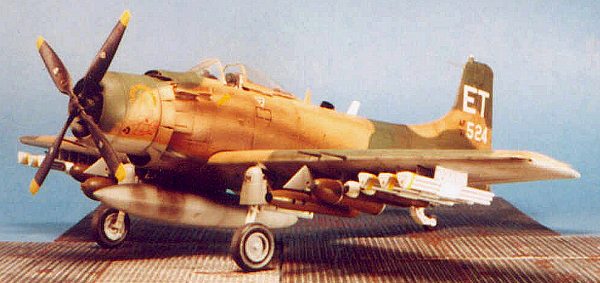
Tamiya 1/48 A-1 Skyraider
|
KIT # |
61058 |
|
PRICE: |
$34 |
|
DECALS: |
See Review |
|
REVIEW: |
|
|
NOTES: |
Aeromaster decals, KMC cockpit and stores` |

|
HISTORY |
Little really needs to be said about the last piston-engine combat aircraft to achieve full production status in the United States. Between 1945 and 1975, the Skyraider created a legend for itself in wars well-known and little-known around the world; in fact, the last ones still flying combat missions were in operation in central Africa as late as 1979-80. The airplane is one of the greats.
I have liked the Skyraider since I first saw one at an air show at NAS Buckley Field outside Denver when I was a kid. (Those who know NAS Buckley Field has been Buckley Field ANGB since 1958 will have an idea just how long ago that was.) The one thing I remember was it was biiiig! Skyraiders were still aboard every aircraft carrier during my Navy days, back in the early Jurassic.
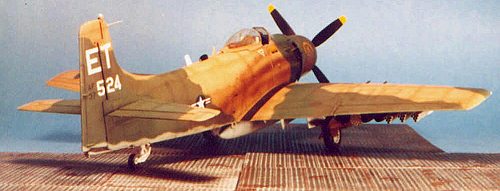 The Air Force came to the
abrupt realization in 1963 that they were going to be fighting small brushfire
wars in out of the way places under primitive conditions, and that it might not
hurt to have some airplanes that could carry a heavier load with more firepower
and performance than a re-built T-28. The only airplane that could fill the bill
was the Douglas Skyraider, even if it was a g--d--- Navy airplane.
The Air Force came to the
abrupt realization in 1963 that they were going to be fighting small brushfire
wars in out of the way places under primitive conditions, and that it might not
hurt to have some airplanes that could carry a heavier load with more firepower
and performance than a re-built T-28. The only airplane that could fill the bill
was the Douglas Skyraider, even if it was a g--d--- Navy airplane.
The Skyraider would create an enviable record for itself, being essentially a World War II-era airplane fighting in a supersonic jets and guided missile environment. Nicknamed the "Spad" in tribute to its age, it was also commonly called the "flying dump truck" for its ability to carry up to its own weight in underwing ordnance, and it could stay over the target far longer than any other aircraft in the inventory. As slow as it was, it was hard to knock down because it could take so much punishment. As the "Sandy" escort for the "Jolly Green Giants" that went into North Vietnam to rescue downed aircrew, the airplane was beloved by those who owed their lives to its capabilities. Even today, as a restored warbird, the Skyraider can draw a crowd, if only for its sheer size. It may look plain, but it's a bird with its own inimitable style.
|
THE KIT |
Monogram brought out a Skyraider in the late 1970s, which was state-of-the-art at the time of its appearance, and which has been re-released any number of times in the intervening 23 years and still makes up into an accurate representation of this airplane with only a modicum of effort.
In 1998, Tamiya bought out what has to be the definitive Skyraider kit. The model is accurate in outline and details, and the kit is so well-engineered it really does "fall together." The first release was the U.S. Navy AD-6/A-1H version.
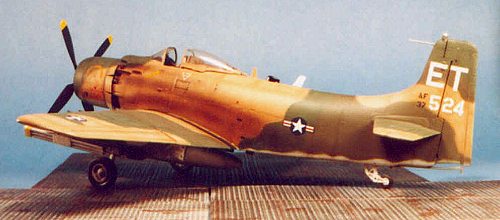 The modeler who wished to
make the Air Force "Spad" needed to obtain a resin cockpit with the Yankee
ejection seat the Air Force installed in its Skyraiders. Fortunately, KMC had
brought out a resin kit of the cockpit and seat for the Monogram kit, and this
would fit the Tamiya kit with only a bit of re-shaping - this is now out of
production but can be found at good prices at swap shows. Meteor
Productions/Cutting Edge released a cockpit and seat for the "Spad" in 1999,
which is still available. In 2000, Tamiya itself released an Air Force "Spad."
While the underwing ordnance offered is first class, the seat still needs
replacement with one made in resin if accuracy of the final look is any concern
to the model-builder.
The modeler who wished to
make the Air Force "Spad" needed to obtain a resin cockpit with the Yankee
ejection seat the Air Force installed in its Skyraiders. Fortunately, KMC had
brought out a resin kit of the cockpit and seat for the Monogram kit, and this
would fit the Tamiya kit with only a bit of re-shaping - this is now out of
production but can be found at good prices at swap shows. Meteor
Productions/Cutting Edge released a cockpit and seat for the "Spad" in 1999,
which is still available. In 2000, Tamiya itself released an Air Force "Spad."
While the underwing ordnance offered is first class, the seat still needs
replacement with one made in resin if accuracy of the final look is any concern
to the model-builder.
There are several decal sheets made by Aeromaster for the Air Force Skyraider, as well as at least one Cutting Edge sheet I am aware of.
My model, originally purchased in 1999, is the Navy version, with the KMC seat, and the KMC underwing load, the only aftermarket set I am aware of that includes the 7.62mm gun pods carried by Air Force Skyraiders on their "Sandy" SAR missions. While the fuselage was assembled with the cockpit shortly after purchase, the kit languished for some reason I can't really explain until earlier this Spring when I decided to complete it.
|
CONSTRUCTION |
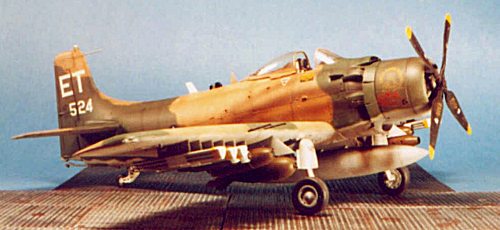 As with any
state-of-the-art Tamiya kit, construction is almost ridiculously simple. I
painted the cockpit interior and the interior of the engine cowling Dark Ghost
Grey, picked out the instruments in the cockpit, and painted the Yankee seat per
the instructions in the KMC set. Once I decided to complete the kit, it was
assembled in a weekend and ready to go to the paint shop.
As with any
state-of-the-art Tamiya kit, construction is almost ridiculously simple. I
painted the cockpit interior and the interior of the engine cowling Dark Ghost
Grey, picked out the instruments in the cockpit, and painted the Yankee seat per
the instructions in the KMC set. Once I decided to complete the kit, it was
assembled in a weekend and ready to go to the paint shop.
A few things modelers should be aware of with this kit is that the dive brakes - while molded separately in the kit - were almost never open on the ground, and certainly the underside dive brake was never open on the ground. Additionally, the flaps were almost never in the lowered position when the airplane was parked on the ground, even if it does in fact look nice as a model to place them in that position. It's up to you, but if you are going for realism, close up the dive brakes and raise the flaps.
I also used the resin boot cover over the canopy actuator mechanism that comes in the KMC set, since Tamiya elected to do the kit with this uncovered, which it almost never was in reality.
|
PAINT & DECALS |
The first thing I did was apply a fairly heavy "pre-shading" of flat black over the panel lines. I then painted the wheel wells gloss white, since they were unchanged in Air Force service from the way they had been in the Navy.
I painted the underside with Tamiya dark grey. The aircraft were delivered operationally with the light grey underside color of standard SEA camouflage, but after they had been on operations for awhile many were painted the darker shade of grey that allowed them to be used on operations by day or night.
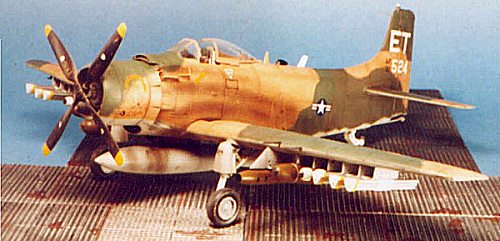 The upper camouflage was
painted with Gunze-Sanyo paints and free-handed with my Paasche Model H
airbrush. I also put on two additional coats of each color with a successive
addition of white to lighten them, to go for the faded look so many Spads had in
Southeast Asia after a few years' service in those conditions. As with any
sun-faded paint job, you want the upper region of the fuselage, and the upper
surfaces of wings and stabilizer to be the lightest, with the colors getting
darker as you work your way down the side, and with very little sun-fading
directly under the stabilizers.
The upper camouflage was
painted with Gunze-Sanyo paints and free-handed with my Paasche Model H
airbrush. I also put on two additional coats of each color with a successive
addition of white to lighten them, to go for the faded look so many Spads had in
Southeast Asia after a few years' service in those conditions. As with any
sun-faded paint job, you want the upper region of the fuselage, and the upper
surfaces of wings and stabilizer to be the lightest, with the colors getting
darker as you work your way down the side, and with very little sun-fading
directly under the stabilizers.
I went to the Skyraider Organization Website (www.skyraider.org) and looked at the many color photographs there of Spads with underwing ordnance loads to get the right color for the rocket pods, mini-gun pods, and bomblet dispensers.
Decals:
Anyone old enough to have been to Vietnam (as I have) is old enough to remember Harvey Kurtzman's sexy cartoon character "Little Annie Fannie" who appeared in Playboy throughout the era. In many ways, she was the first "underground comics" character. I knew I was going to do that airplane the first time I saw the noseart on the Aeromaster 48-377 "Airwar Over Vietnam Part 9" decal sheet. I also used the stencilling from a Third Group decal sheet for Skyraiders I had in my collection.
Final Assembly:
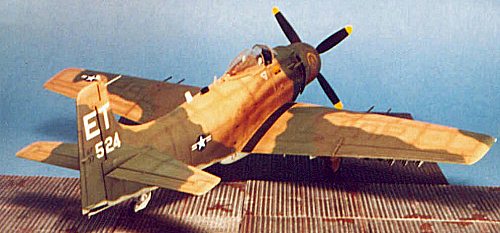 Once the model had been
finished in Dullcote and the landing gear attached, it was time for some serious
weathering. While I am generally a believer in the "less is more" school of
weathering, with the Skyraider the truth of the matter is that "too much is
likely not enough" when it comes to exhaust stains and oil smears. The R-3350
was a dirty engine, and Skyraider pilots have been known to refuse to fly an
airplane on the grounds it was "too clean" and therefore likely unsafe.
Once the model had been
finished in Dullcote and the landing gear attached, it was time for some serious
weathering. While I am generally a believer in the "less is more" school of
weathering, with the Skyraider the truth of the matter is that "too much is
likely not enough" when it comes to exhaust stains and oil smears. The R-3350
was a dirty engine, and Skyraider pilots have been known to refuse to fly an
airplane on the grounds it was "too clean" and therefore likely unsafe.
I applied exhaust staining with Tamiya "Smoke," finishing it by dripping thinned "Smoke" with a brush with the airplane on its gear, allowing the paint to flow from the force of gravity to simulate the oil smears one can see on any Skyraider. I also dirtied up the underside of the airplane and "dripped oil" on the centerline tank. Even with all this, a former Skyraider pilot I know took a look at the model and said "that's a pretty clean airplane, you know?" Oh, well.
The underwing ordnance was attached, the various antennas were put in position, the canopy was set in the open position, the propeller was attached and....
Voila! "Little Annie Fannie," the GI's friend.
|
CONCLUSIONS |
I would recommend a modeler who wants to do the Air Force "Spad" nowadays buy the correct Tamiya kit for this version, since the underwing ordnance selection is very good. You really do need to get a resin Yankee seat, though.
If you would like your product reviewed fairly and fairly quickly, please contact the editor or see other details in the Note to Contributors.
Back to Reviews Page 2019